Pump Handbook by Igor J. Karassik, Joseph P. Messina, Paul Cooper, Charles C. Heald - 3rd edition
Подождите немного. Документ загружается.

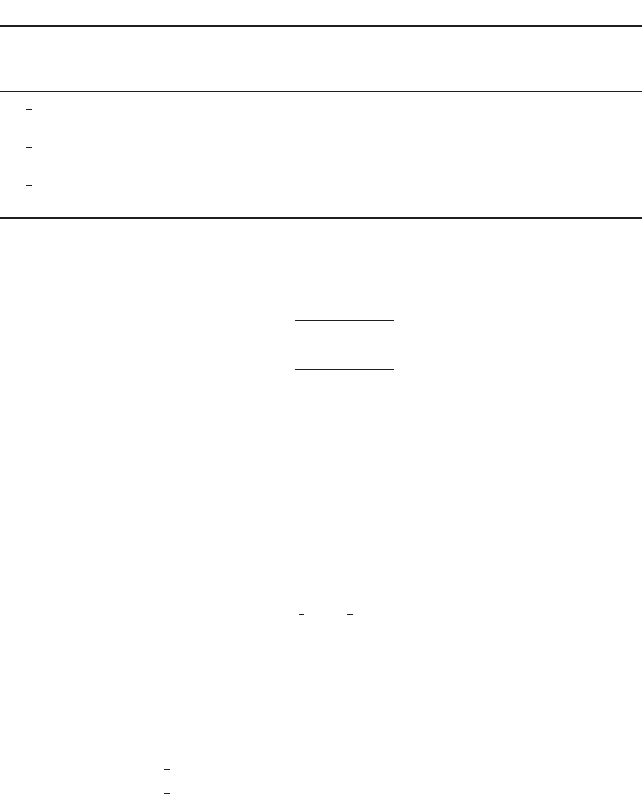
9.17 OIL WELLS 9.385
TABLE 5 External upset tubing data
Tubing Weight
size, in Actual ID, T&C,
a
lb/ft Upset OD, Collar OD, Shrink factor
(mm) in (mm) (kg/m) in (mm) in (mm) K USCS (SI)
2 1.995 4.63 2.594 3.063 0.313
(60.32) (50.67) (6.89) (65.89) (77.80) (5.86)
2 2.441 6.44 3.094 3.668 0.224
(73.02) (62.00) (9.58) (78.59) (93.17) (4.20)
3 2.992 9.27 3.750 4.500 0.151
(88.90) (76.00) (13.80) (95.25) (114.30) (2.83)
a
Threaded and coupled
1
2
7
8
3
8
in USCS units
in SI units
where R
t
is the total length of rod string in 1000 feet (kilometers).
SUCKER ROD STRETCH, TUBING SHRINK
The sucker rod stretch starts when the plunger starts
its upstroke and the fluid load is transferred from the tubing string to the sucker rod
string. This occurs when the standing valve opens and the traveling valve closes. As the
sucker rod string lengthens, the tubing string shortens. Both result in a stroke loss. The
stroke loss due to rod stretch is shown in Table 2 as factor C, and the stroke loss due to
tubing shrink is shown in Table 5 as factor K. Both are in inches per 1000 feet per 1000
pounds load (millimeters per kilometer per kilonewton).
NET PLUNGER STROKE The formula below illustrates a method of computing the net
plunger stroke for a tapered string of 1-, - and -in (25.4-, 22.2- and 19.0-mm) rods with
the tubing suspended freely. If the tubing is anchored to the well casing near the pump,
the KR
t
factor will be zero.
In USCS units
In SI units
where L
p
net plunger stroke, in (m)
R
1
length of -in (19.0-mm) rods, 1000 ft (km)
R
2
length of -in (22.2-mm) rods, 1000 ft (km)
R
3
length of 1-in (25.4-mm) rods, 1000 ft (km)
R
t
length of tubing string, 1000 ft (km)
For a single-size rod string, zero values are assigned to the sizes not used. The pump
displacement can now be calculated with the formula
in USCS units,
in SI units
The 0.8 factor assumes an 80% pump volumetric efficiency after correcting for sucker
rod stretch and plunger overtravel. A lower efficiency should be assumed if the well is
known to be gassy. If the pump displacement is more than required and the torque and
Cubic meters>day L
p
bore factor spm 0.8
Barrels>day L
p
bore factor spm 0.8
7
8
3
4
L
p
L OT 1CR
1
CR
2
CR
3
KR
t
2W
f
10
6
L
p
L OT 1CR
1
CR
2
CR
3
KR
t
2W
f
10
3
3
4
7
8
OT
1R
t
spm2
2
L
4645
OT
1R
t
spm2
2
L
50,000
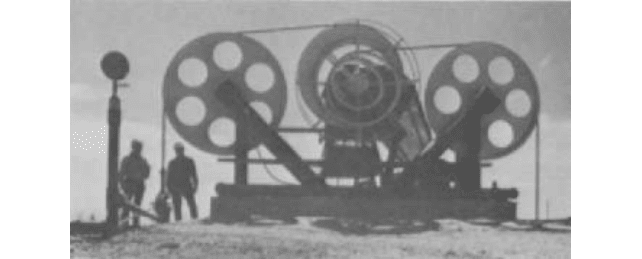
9.386 CHAPTER NINE
structure capacity ratings of the unit are not exceeded, the calculations should be repeated
using the next smaller size unit.
COUNTERBALANCE
The pumping unit is supplied with a counterbalance in order to load
the prime mover equally on the upstroke and the downstroke. The counterweights bal-
ance out the wet weight of the rods and half the weight of the fluid. All of the work in lift-
ing is done on the upstroke. The energy stored in the counterweights during the
downstroke supplies about half of the energy required for lifting the fluid. Because it lifted
no fluid on the downstroke, the prime mover expends its energy lifting the unbalanced
portion of the counterbalance load. Counterbalance effect CB is
The pumping unit pictured in Figure 1 is known as a beam pumping unit. These are
most common, but there are other types. One is a hydraulic surface unit, where a cylinder
is set directly over the wellhead and a piston provides the reciprocating motion of the rods.
These use commercial hydraulic pumps and control valves to supply the hydraulic power
to the piston.
As shown in Table 3, standard sizes of beam pumping units have stroke lengths rang-
ing from a little more than 1 ft (0.3 m) to a maximum of 16 ft (4.9 m). Recently a number
of units have been marketed that permit stroke lengths up to 40 ft (12 m). The long stroke
improves pump efficiency, prolongs sucker rod life, and reduces energy requirement. The
unit pictured in Figure 5 uses wire line wound and unwound on a reversible drum to sup-
ply the reciprocating motion.
SUBSURFACE HYDRAULIC PUMPING SYSTEM ___________________________
A complete hydraulic system consists of a fluid cleaning system, a power pump (usually
a triplex), surface controls, a subsurface hydraulic pump, and tubing connecting the sur-
face power pump to the subsurface pump. (See Section 3.1 for a complete description of
power pumps.) Figure 6 is a schematic drawing of a complete multiple-well hydraulic
system.
Because the pressurized power fluid supplies the energy needed to pump the well, the
heavy sucker rod string and the heavy structure of the pumping unit required with the
sucker rod pump are eliminated. Therefore, the hydraulic system can produce larger vol-
umes of fluid from greater depths than the sucker rod pump.
The subsurface pump can be either a reciprocating piston pump or a jet pump. Both are
usually made to be interchangeable in the same subsurface installation. Both pumps are
CB W
w
1>2 W
f
FIGURE 5 Winch pumping unit (Bethlehem Steel)
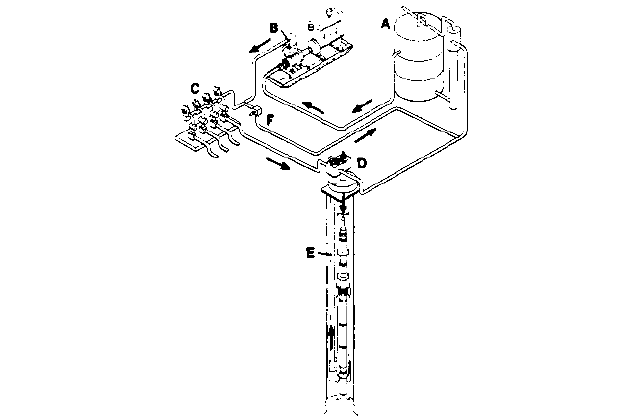
9.17 OIL WELLS 9.387
FIGURE 6 Multiple-well hydraulic installation: (A) power fluid tank, (B) triplex pump, (C) manifold, (D) well-
head, (E) tubing, (F) bypass valve (Kobe)
*Individual joints of tubing coupled together to reach from the wellhead to the subsurface pump are called tubing
strings.
made in what is called the free pump configuration, which means that the pump assem-
bly can be pumped down into the well or pumped out of it by the same surface power fluid
system that powers the pump during normal operation with the pump on the bottom. The
free pump feature gives the hydraulic pump a distinct servicing advantage over the sucker
rod pump, which requires a mast or derrick over the well and a pulling unit to pull the rods
one or two at a time when the pump needs servicing.
There are two basic types of hydraulic installations for the free pump: parallel free and
casing free. Both result in a U-tube arrangement in which one leg of the U tube delivers
the power fluid to the pump at the bottom and the other leg directs spent power fluid plus
production back up to the surface. In the parallel free system, two parallel tubing strings*
make up the U tube, and both are lowered into the well casing. In the casing free system,
only one string is lowered into the well, and the annulus between this tubing and the well
casing acts as the second leg of the U tube. Figure 7a illustrates installing a hydraulic
pump in a parallel-free installation. A standing valve closes the bottom of the U tube, and
the two strings are filled with fluid. The pump is inserted into the power fluid string,
which is then securely capped, and the four-way valve is set to pump power fluid down the
power fluid tubing. When the hydraulic pump reaches the bottom, a tapered bottom plug
engages a seat on the standing valve and forms a pressure-tight seal. At the same time, an
elastomer seal at the top of the pump enters a seal that now forces power fluid into the
hydraulic pump (Figure 7b) to start it pumping (as described later). When it is desired to
retrieve the pump to replace worn parts, the position of the four-way valve is reversed and
power fluid is directed down the production tubing (Figure 7c.) The standing valve closes,
the pump is unseated, and the circulation of fluid carries the pump to the surface, where
it latches into the cap.The pressure is bled off from the U tube, and the wellhead cap with
the worn pump is removed from the well.
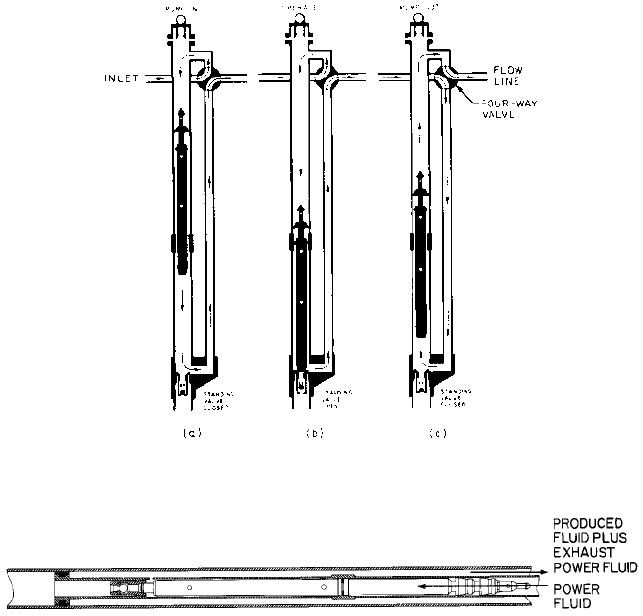
9.388 CHAPTER NINE
FIGURE 7A through C Hydraulic parallel free pump installation
FIGURE 8 Casing free installation
The casing free installation (Figure 8) employs a packer that anchors and seals the tub-
ing to the casing just below the pump assembly. The annulus between the tubing and cas-
ing above the packer takes the place of the production string in the parallel free
installation. In operation, the power fluid is pumped down the power fluid string as before,
but the mixture of exhaust power fluid plus production is returned to the surface in the
tubing casing annulus.The annulus below the standing valve is at pump suction pressure.
The casing free hydraulic pump installation is more economical because it requires only
one string of tubing. It also has the advantage that the return fluid passage up the annu-
lus is very large and fluid frictional losses are very low.
Natural gas separates from the crude oil as it enters the well bore. In the parallel free
installation, this gas rises to the surface in the annulus between the tubing strings and the
casing, entering the flow line with the produced fluid at the wellhead. In the casing free
installation, however, this annulus is used to return the liquid discharged from the pump,
and all of the produced gas must be pumped with the produced liquid. The hydraulic pump
is not very efficient in pumping gas.Therefore, in gassy wells, the pump efficiencies for the
casing free system will be lower.
Both the reciprocating hydraulic pump and the jet pump are designed to operate on
fluid from the well. Either crude oil or water may be used as the power fluid. Sand parti-
cles and other abrasives contained in the produced fluid are removed either by gravity sep-
aration in surface settling tanks or by centrifugal force in cyclone separators.The cleaned
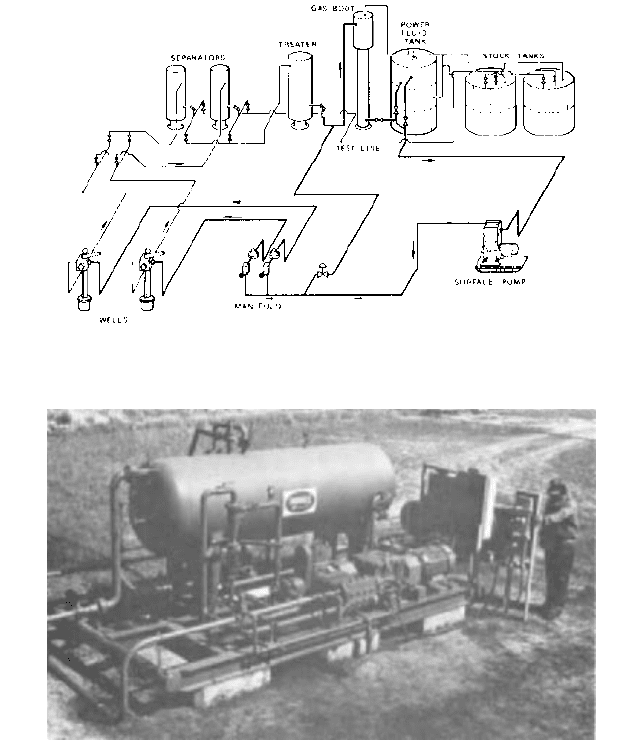
9.17 OIL WELLS 9.389
FIGURE 9 Typical central system (Kobe)
FIGURE 10 One-well unitized system (National Supply)
oil or water is then pressurized
—
typically to between 2500 and 4000 lb/in
2
(172 and 276
bar)
—
by a power pump at the surface, and then the high-pressure fluid is returned down
the power fluid tubing to operate the subsurface hydraulic pump. The exhausted power
fluid from the hydraulic pump mixes with the produced fluid from the well, and the mix-
ture is returned to the surface in the parallel side string or the casing tubing annulus.
Figure 9 illustrates a typical central system. The power fluid is separated by settling
in tanks. A triplex pump or a battery of triplex pumps manifolded together supplies the
power fluid to a number of oil wells. Figure 10 shows a one-well unitized system, in which
the combined stream of well production and power fluid is brought into a pressure vessel
for a brief period for gas separation and solids settling. The selected fluid is then passed
through a cyclone for cleaning before going to the surface pump. The abrasive-laden
underflow from the cyclone and the surplus fluid from the pressure vessel then go into the
flow line and are carried to the lease tanks. This fluid constitutes the well production.

9.390 CHAPTER NINE
Subsurface Reciprocating Hydraulic Pumps A subsurface reciprocating hydraulic
pump basically consists of an engine piston and cylinder with an engine reversing valve,
and a pump barrel and plunger. These are assembled into one unit, and a polished rod
connects the engine piston to the pump plunger so the two reciprocate together.
Several designs of subsurface hydraulic reciprocating pumps are available. Figure 11a
is a schematic of a double-acting pump.The engine valve directs high-pressure power fluid
below the piston and opens the area above the piston to exhaust pressure on the upstroke.
On the downstroke, it directs high-pressure power fluid above the piston and exhausts the
power fluid below the piston to low pressure. The double-acting design exhausts an equal
amount of power fluid from the engine and produces fluid from the pump on the upstroke
and downstroke.
Figure 11b illustrates a balanced-design pump where the polished rod area is equal to
half of the piston area. The underside of the piston is always connected to high-pressure
power fluid. On the downstroke, the engine valve directs high pressure on top of the pis-
ton. Because this area is larger than the bottom area of the piston, the unit makes a down-
stroke. On the upstroke, the engine valve exhausts the area above the piston to low
pressure. The high pressure below the piston then causes the unit to make an upstroke.
The balanced design exhausts all of the spent power fluid on the upstroke and all of the
produced fluid displaced by the pump on the downstroke.
Figure 11c illustrates a single-acting pump where the polished rod area is small relative
to the piston area. The underside of the piston is always connected to high-pressure power
fluid. The engine valve directs high-pressure power fluid to the top of the piston on the
downstroke and exhausts it to low pressure on the upstroke.The single-acting unit exhausts
all of the exhaust power fluid and most of the produced fluid displaced by the pump on the
upstroke. Only the displacement of the polished rod is exhausted on the downstroke.
In general, subsurface hydraulic reciprocating pumps are used in small- to medium-
volume wells. When they are installed in 2 -in (60-mm) OD tubing, they are most com-
monly used to produce 25 to 500 barrels/day (4 to 80 m
3
/day); in 2 -in (73-mm) OD tubing,
from 50 to 1000 barrels/day (8 to 158 m
3
/day); and in 3 -in (89-mm) OD tubing, from 100 to
1500 barrels/day (16 to 240 m
3
/day). Where conditions are right, these volumes can be
exceeded, but in the higher volume ranges, the jet pump is usually a better application.
Most subsurface hydraulic units have a maximum power fluid pressure rating of 4000
lb/in
2
(278 bar).
Reciprocating hydraulic pumps are available in several pressure ratios. For moderate-
depth wells, the engine cylinder and the pump barrel can be of the same diameter. In deeper
wells, a pump plunger smaller than the engine cylinder is used; thus the operating pressure
can be reduced proportionally, but a proportionally greater quantity of power fluid will be
required. Hydraulic pumps are also offered with tandem engines and single pump for deep
wells and with single engine and tandem pumps for shallow wells.The pump-to-engine-area
ratio in these models varies from a low of 0.40 to a high of 2.00. There is no standardization
of design among the various manufacturers, and the models of each are so diverse that no
typical charts are offered here. Data can be obtained from the individual manufacturers.
As mentioned previously, the complete up and down cycle of the piston and plunger is
called a stroke, and the distance traveled in one direction is called the stroke length.
Stroke lengths offered vary from 1 to 5 ft (0.3 to 1.5 m). Stroke-per-minute ratings are from
200 on the shortest stroke to 50 on the longest stroke. The strokes are visible on the sur-
face pressure gage because the pressure rises at each reversal when fluid flow is momen-
tarily interrupted. Because the triplex power pump is positive displacement, the power
fluid rate to the pump is usually controlled by bypassing the unneeded surplus. Some
triplex pumps are equipped with a three-speed manual transmission that can be used to
vary the speed of the surface pump. By selecting the proper rotational speed, the output
volume of the surface pump can be adjusted closely to the requirements of the subsurface
pump. The triplex pump normally runs continuously, although occasionally in small-
volume wells, it will be run intermittently by a time clock.
Subsurface Jet Pumps A jet pump has no moving parts, but it pumps by transferring
momentum from a very-high-velocity
—
1000 ft/s (300m/s)-fluid jet to the pumped fluid
1
2
7
8
3
8
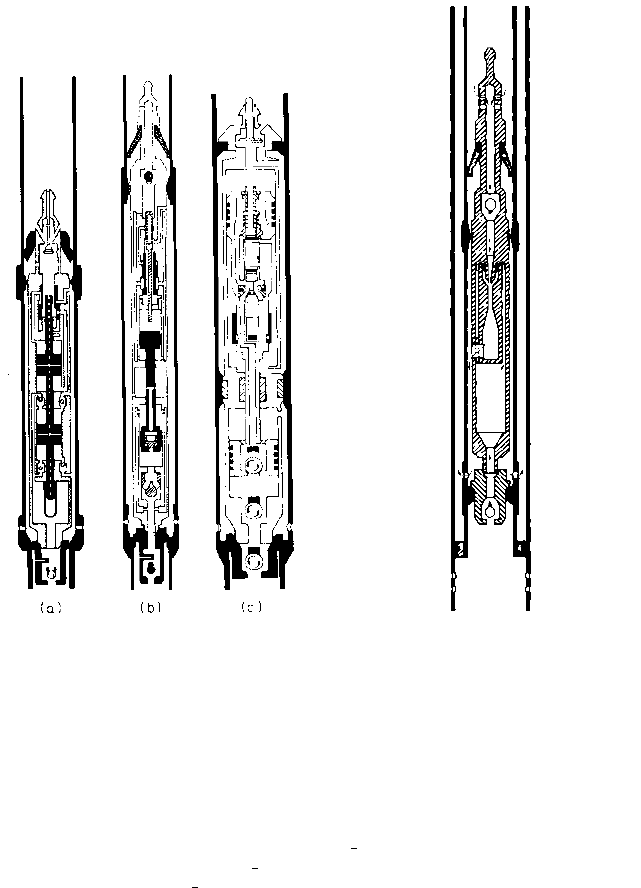
9.17 OIL WELLS 9.391
FIGURE 12 Jet free pump
FIGURE 11 Designs of subsurface hydraulic pumps:
(a) double-acting, (b) balanced, (c) single-acting
(Figure 12). At the nozzle exit, the jet creates a low-pressure area, thereby drawing in the
fluid and carrying it to the throat of the pump, where the momentum transfer is com-
pleted. Then the combined stream enters the expanding tapered section of the diffuser,
where the velocity head is converted back to a static head. The static head at this point
is sufficient to lift the combined stream back to the surface. For a complete description of
the general theory of jet pumps, see Chapter 4.
The jet pump has a broad range of application. It has been applied in wells as shallow
as 800 ft (240 m) and as deep as 15,000 ft (4800 m). In general, a jet pump is capable of pro-
ducing wells in the following volume ranges: in 2 -in (60-mm) OD tubing, from 25 to 8000
barrels/day (4 to 475 m
3
/day); in 2 -in (73-mm) OD tubing, from 50 to 6000 barrels/day
(8 to 950 m
3
/day); and in 3 -in (89-mm) OD tubing, from 100 to 12,000 barrels/day (16 to
1900 m
3
/day).
Jet pumps are less energy-efficient than reciprocating pumps. A well-designed jet
pump may perform at approximately 40% hydraulic efficiency, as compared with more
than 90% efficiency for a reciprocating pump. However, jet pumps do have numerous
advantages.With no moving parts, they have a high level of reliability, and sustained runs
of several years are not uncommon. In addition to their high volume capability, jet pumps
have a higher tolerance to abrasives in the produced fluid as well as in the power fluid.
They are also more efficient in handling entrained gas in the pumped fluid.
1
2
7
8
3
8
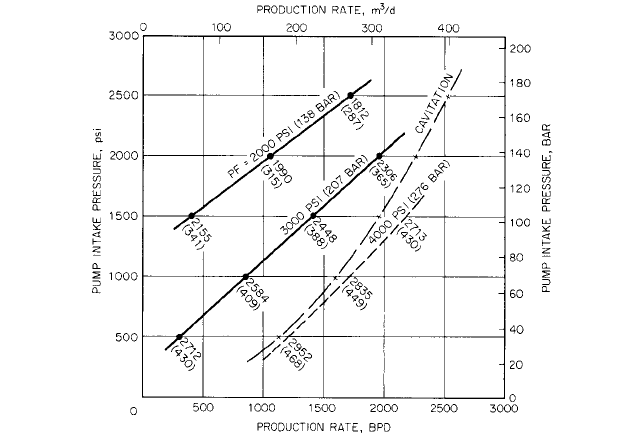
9.392 CHAPTER NINE
FIGURE 13 Typical characteristic curves for a jet pump. Numbers adjacent to curves are power fluid in barrels
(cubic meters) per day. Jet pump operation must be above and to the left of cavitation line.
Manufacturers offer a broad range of nozzle and throat sizes to cover the varied
requirements of depths and volumes. Published data show the smallest nozzle requires
13.5 hydraulic hp (10 kW) and the largest requires 506 hydraulic hp (377 kW) at 4000
lb/in
2
(276 bar) power pump pressure. It requires a complex calculation to determine the
optimum nozzle and throat sizes for any given set of well conditions. Manufacturers offer
computer solutions, usually in graphical form. Variable factors such as tubing friction,
changing specific gravity due to gas, and changing well conditions all contribute to the
need of a graphical presentation. The chart in Figure 13 shows a jet pump calculation for
an 8000-ft (2440-m) well to predict the anticipated production volume versus pump intake
pressure for power fluid pressures of 2000, 3000, and 4000 lb/in
2
(138, 207, and 276 bar).
Note that at 4000 lb/in
2
(276 bar) power oil pressure, the pump would be cavitating, and
this condition must be avoided. Cavitation occurs when the pressure at the entrance of the
throat is less than the vapor pressure of the fluid pumped. The collapse of cavitation bub-
bles in the throat is so damaging that no known metal can resist destruction. Throat life
in severe cavitation can be as short as two or three days. It may also be noted from the
chart that the jet is very sensitive to pump intake pressure. Both the production rate and
the overall hydraulic efficiency increase as pump intake (suction) pressure increases. A
down-well pressure-recording instrument may be installed with the jet pump. It records
pump intake pressure versus time for a six-day period, at the end of which the jet pump
with the instrument is pumped out and the pressure recording read and analyzed. This
information is then used to determine if the nozzle and throat sizes are optimum and to
select the power fluid pressure that will maximize production but still avoid cavitation.
Subsurface Progressing Cavity Pumps A positive displacement screw-type pump
(Section 3.7) can be used for handling the range of oil field fluids. Rotative speed can be
varied to match well production with a smooth and steady delivery. No valves are required
for pump operation. This type of pump is well suited to handling gaseous formations.
As shown in Figure 14, the rotor is a single rounded-cross-section external screw. The
stator is a double internal helix molded of synthetic rubber. As the rotor turns, cavities
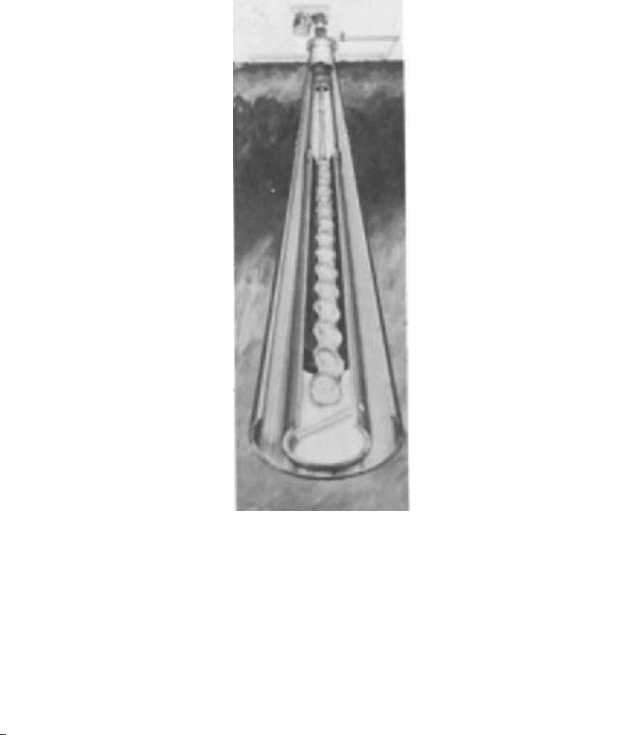
9.17 OIL WELLS 9.393
FIGURE 14 Subsurface progressing cavity pump (Fluids Handling Division, Robbins & Myers)
form, and these cavities remain the same size as they progress from the bottom suction to
the top discharge. The pump stator is suspended from a standard API tubing string and
driven by standard API sucker rod. The pump is electric-motor-driven through belts and
sheaves to obtain desired speeds.
Pumps of this type are available for oil well services (or for pumping fluids out of gas
wells) to 3000 ft (914) or more. For pumping light or heavy crudes, pump sizes are avail-
able up to 100 barrels/day (16 m
3
/day) with speeds varying up to 550 rpm and power rat-
ings to 5 hp (3.7 kW), depending on the well depth and flow required. A sucker rod size of
in (15.9 mm) is common.
ELECTRIC SUBMERSIBLE CENTRIFUGAL PUMPS ________________________
Electric submersible centrifugal pumps are adapted to a wide variety of pumping condi-
tions. However, because of their high capacity, they are most frequently installed in wells
where the volume of fluid to be produced exceeds the capacity of sucker rod or reciprocat-
ing hydraulic pumps. They are installed suspended from the discharge tubing and sub-
merged in the well fluid. A three-conductor electric cable strapped to the discharge tubing
transmits the power to the motor to the end of the pump.
The electric submersible pump system is illustrated schematically in Figure 15. The
electric motor and pump rotate at 3500 rpm to 60-Hz power and 2900 rpm for 50-Hz
power. The electric motor is directly coupled to the pump with a seal section between the
two. The motor is filled with an oil especially selected to provide high dielectric strength,
lubrication for the bearings, and good thermal conductivity. The seal section isolates this
5
8
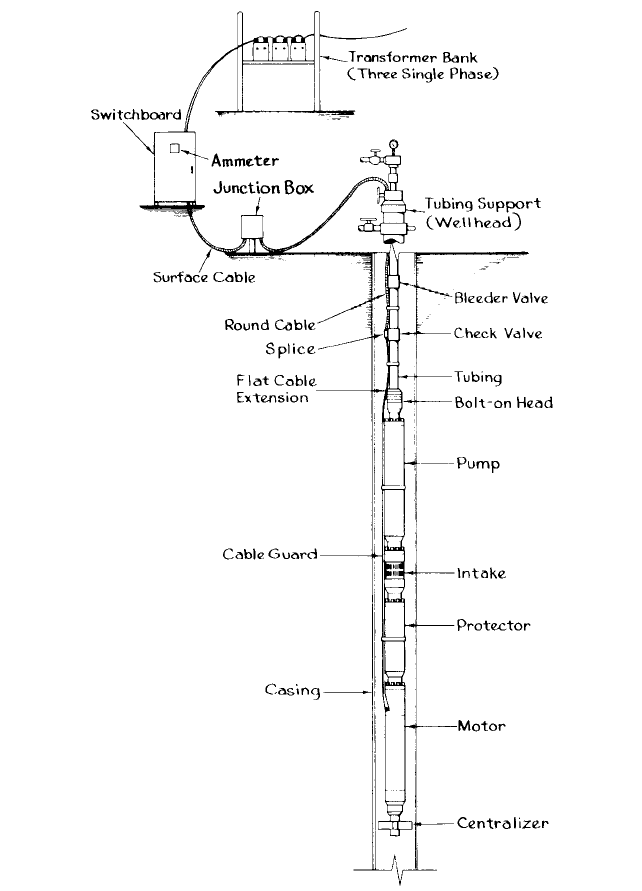
9.394 CHAPTER NINE
FIGURE 15 Electric submersible centrifugal pump system (PennWell Publishing)
fluid from the pump and allows for expansion and contraction of the fluid with tempera-
ture changes at the bottom of the well. The motor, which is the bottom element of the
assembly, is usually installed in the well above the casing perforations where the fluid
enters the well bore.This allows all of the fluid entering the pump suction to flow past the
motor housing and provide the needed cooling.
